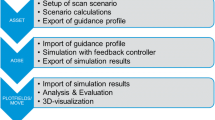Abstract
The new generation of agile earth observation satellites provides much higher observation capabilities than their non-agile predecessors. From a kinematic point of view, these capabilities result in more complex guidance laws for the spacecraft’s attitude control system. The computation of these guidance laws is driven by a number of factors. For instance, the Earth’s curved shape and its rotation in combination with the possible scan path geometries lead to a highly nonlinear relation between the motion of the satellite and the line-of-sight projection onto Earth. In this paper ASSET (Agile Satellites Scenario Evaluation Tool) is presented. ASSET is a modular MATLAB command line tool developed at Astrium GmbH, Germany, to asses the manoeuvre capabilities of agile satellites carrying time-delayed integration instruments. Each single scenario may consist of one or several ground scans, linked by suitable spacecraft slews. Once the entire scenario is defined, ASSET will analyse whether the kinematic and dynamic constraints of a specific satellite allow this scenario to be performed and will then generate the related guidance profile (angles and angular rates). The satellites’ ground track, the projection of the instruments line-of-sight, and the projection of the instruments field of view onto the earth can be plotted for a visual inspection. ASSET can perform the analysis of scenarios with several different scan modes usually performed by this type of satellite.











Similar content being viewed by others
Notes
The problem of time optimal spacecraft reorientation falls into the field of optimal control and has been widely discussed in the literature [9–11]. Today, a proof for a time optimal non-rest to non-rest attitude manoeuvre is still missing. The function used for ASSET represents a higher-order polynomial solution and is considered to be close to the unknown optimal one.
As disturbances are not included in the simulation, the momentum storage capabilities of the actuators are defined by the maximum allowed rotation rate. The example scenario assumes 2°/s maximum allowed rotation rate, which results in required momentum storage capabilities of 17.45 Nms per axis and wheel. A reaction wheel, which can provide such torque is described in [13].
References
Jacobsen, K.: High resolution satellite imaging systems – overview. Photogramm. Fernerkund. Geoinf. 6, 487–496 (2005)
Lemaitre, M., Verfaillie, G., Jouhaud, F., Lachiver, J.-M., Bataille, N.: How to manage the new generation of agile earth observation satellites. In: 6th International Space Operations Symposium, Toulouse, France (2000)
Baudoin, A.: Beyond Spot 5: Pleiades, part of the French-Italian program Orfeo. Int. Arch. Photogramm. Remote Sens. Spat. Inf. Sci. 35, 260–267 (2004)
Poli, D.: Modelling of spaceborne linear array sensors. Doctoral thesis, ETH Zurich, Switzerland (2005)
Wong, H.-S., Yao, Y.L., Schlig, E.S.: TDI charge-coupled devices: design and applications. IBM J. Res. Dev. 36, 83–106 (1992)
Hahn, M., Müller, T., Levenhagen, J.: An optimized end-to-end process for analysis of agile earth observation satellite missions. In: Proceedings of the 62nd German Aerospace Congress, September 10–13, Stuttgart, Germany (2013)
de Lussy, F., Kubik, P., Greslou, D., Pascal, V., Gigord, P., Cantou, J.P.: Pleiades-HR image system products and quality Pleiades-HR image system products and geometric accuracy. 2005. http://www.ipi.uni-hannover.de/fileadmin/institut/pdf/075-delussy.pdf. Accessed 15 Aug 2011
Chen, L.C., Teo, T.A.: Orbit adjustment for EROS A1 high resolution satellite images. In: Proceedings of the 22nd Asian Conference on Remote Sensing, November 5–9, Singapore 1169–1174 (2001)
Bilimoria, K., Wie, B.: Time-optimal three-axis reorientation of a rigid spacecraft, guidance. Control Dyn. 16, 446–452 (1993)
Beaumet, G., Verfaillie, G., Charmeau, M.-C.: Estimation of the minimal duration of an attitude change for an autonomous agile earth-observing satellite. In: Proceedings of the 13th International Conference on Principles and Practice of Constraint Programming, September 23–27, Providence, RI, USA, pp. 3–17 (2007)
Fleming, A.: Real-time optimal slew maneuver design and control. Masters thesis, Naval Postgraduate School (2004)
Barschke, M.: Design and analysis of manoeuvre scenarios for highly agile satellites. Masters thesis, Cranfield University (2011)
Bialke, B., Stromswold, E.: Reaction wheel actuator with two Newton-meter torque capability for increased spacecraft agility. In: Proceedings of the 6th International ESA Conference on Guidance, Navigation and Control Systems, October 17–20, Loutraki, Greece (2005)
Löhr, J., Aldinger, J., Winkler, S., Willich, G.: Automated planning for earth observation spacecraft under attitude dynamical contraints. In: Proceedings of the 62nd German Aerospace Congress, September 10–13, Stuttgart, Germany (2013)
Author information
Authors and Affiliations
Corresponding author
Additional information
This paper is based on a presentation at the German Aerospace Congress, September 10–12, 2012, Berlin, Germany.
Rights and permissions
About this article
Cite this article
Barschke, M.F., Levenhagen, J., Reggio, D. et al. ASSET: a software tool for the evaluation of manoeuvre capabilities of highly agile satellites. CEAS Space J 6, 37–45 (2014). https://doi.org/10.1007/s12567-013-0057-2
Received:
Revised:
Accepted:
Published:
Issue Date:
DOI: https://doi.org/10.1007/s12567-013-0057-2




